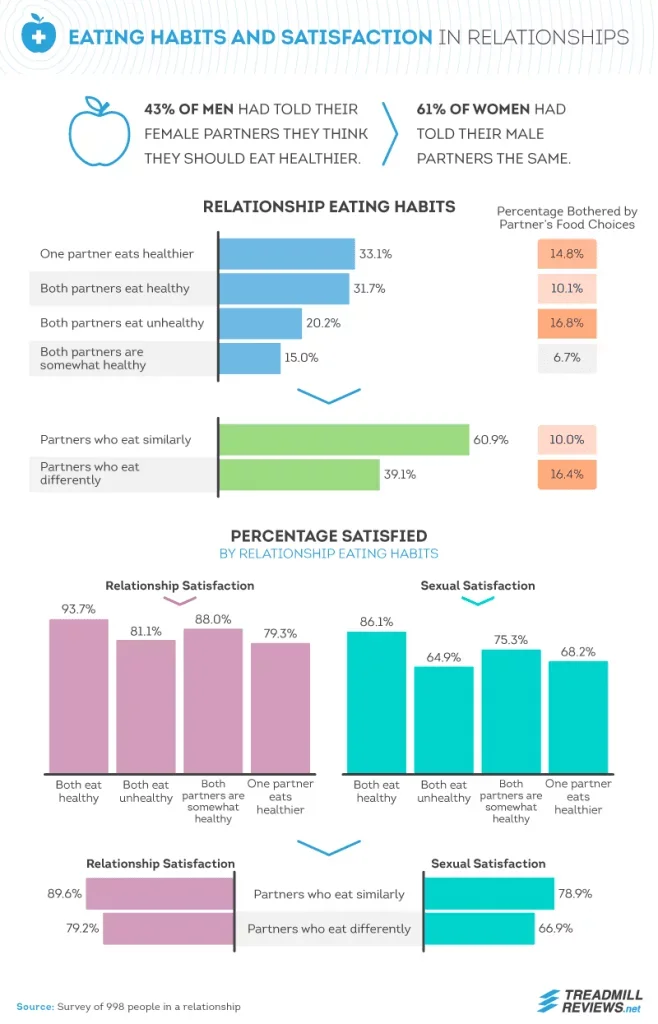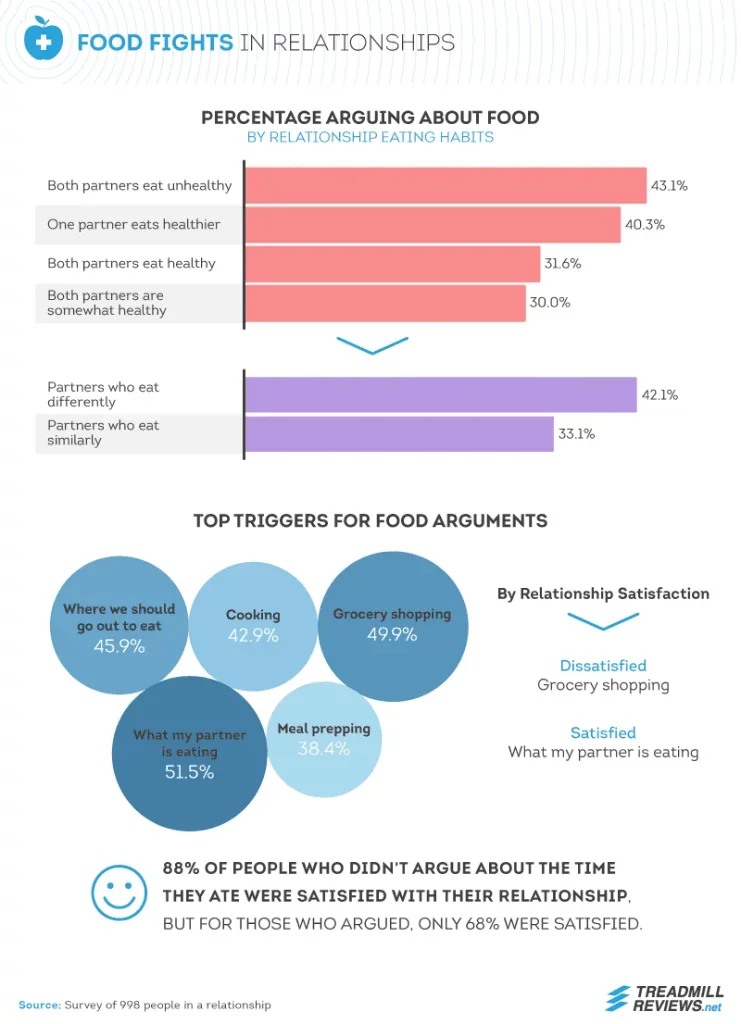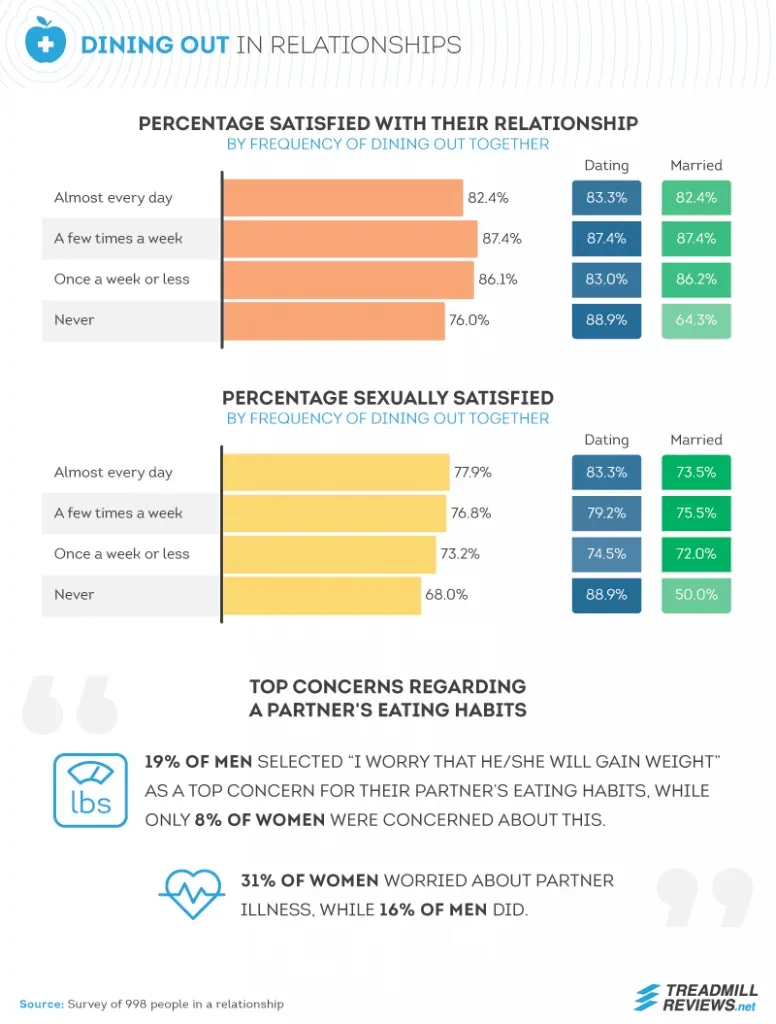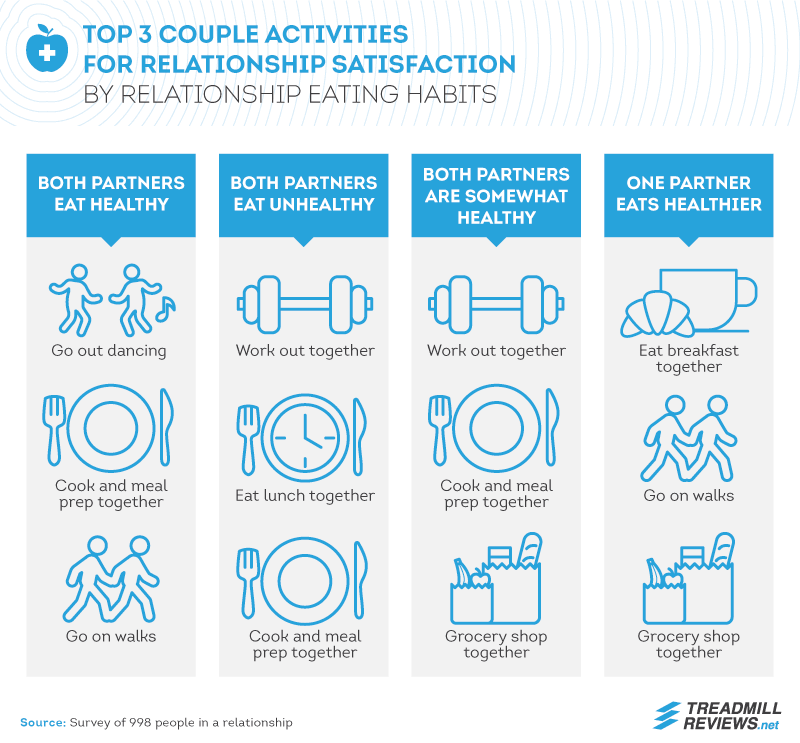There’s a new wave of diet trends in the U.S. Some, such as the ketogenic diet, have gained enough traction that chain restaurants are even adding specialized menu items to feed this growing need. Although these eating habits may seem unorthodox, some people believe they’ll lead to a healthier life. People in relationships might have different ideas about what’s healthy, though. What if one partner decides to keto their way to health, but the other prefers a plant-based diet coupled with morning walks? To better understand the health habits that couples maintain and whether individual preferences have an overall impact on relationship satisfaction, we surveyed nearly 1,000 people in relationships. Continue reading to see what we learned.
Do Similar Eating Habits Bring More Satisfaction?
When students find their way to college, it’s believed they gain the “freshman 15” – a chunk of weight put on due to a change in diet and added stress. We’ve even come to believe that when people enter new romantic relationships, their health habits also change. How so? Happy fat: The happier you are with your lover, the more weight you’ll put on.
Love pounds seem to suggest that when two people maintain the same diet, they tend to experience more satisfaction in the relationship. According to our findings, only 10% of partners who ate similarly were bothered by the eating habits of the other, compared to 16.4% of those who ate differently. And, it turns out, most people in relationships do maintain a similar diet. We found that 60.9% of partners ate similarly.
Something about watching your fiance bite down on a juicy burger while you’re getting ready to consume yours is – sexy. In fact, nearly 79% of partners who ate similarly were sexually satisfied, and 89.6% were satisfied with the overall relationship. Overall, whether your diet is health-conscious, eating similarly to your partner seems to be good for the relationship.
Cause of Food-Related Arguments in Relationships
Conflict happens in relationships, and that reality is no different for couples with similar eating habits. We found that 33.1% of couples who ate similarly argued about food. And when we dove into the data, we discovered that couples were more satisfied when they didn’t argue about food than when they did, with a difference of 14 percentage points.
Eating a healthy diet is not synonymous with an argument-free relationship, though. Of the couples who ate healthy, nearly 32% argued about food. And partners who had different diets – where one ate healthy, and the other didn’t, for example –tended to have more disputes. However, when both people ate an unhealthy diet, they were the most likely to argue about food (43.1%).
Internet memes and comedy sketches often poke fun at women for never knowing what they want to eat, but is that what causes the most food fights in relationships? No. Only 45.9% of arguments about food had to do with where couples should go out to eat. Instead, the No. 1 cause of food fights was distaste for what one partner was eating.
Dining Out and Fitness Activity in Relationships
It’s Friday night – let your hair down and grab a bite to eat. In fact, Americans are spending more money eating out, and sales at restaurants are up more than 4% as a result. Interestingly, 87.4% of couples who dined out a few times per week were satisfied or very satisfied with their relationship. And those who never ate out experienced less satisfaction at 76%.
Couples who dined out almost every day were the most sexually satisfied – it must be because of all the free time they have. And people in dating relationships who ate out almost every day (83.3%) experienced more sexual satisfaction than married couples who did the same (73.5%). Conversely, only 50% of married couples who never dined out were satisfied, while 88.9% of people in dating relationships were satisfied.
It’s not all in the eating, and satisfied partners don’t always have to focus their time and conversations around food. Although maintaining a similar diet is likely to lead to less friction, we learned that couples who participated in daily activities together experienced more relationship satisfaction. Among healthy eaters who were satisfied with their relationships, dancing was the top activity. For couples who may not be as health-focused when it comes to food, working out seemed to lead to the most relationship satisfaction. It’s all about balance, right?
Satisfaction Guaranteed Forever
Our findings suggest that maintaining a relationship where both couples experience sexual satisfaction and are happy being together has a lot to do with maintaining similar habits. While eating healthy is encouraged, couples find more joy when their habits are alike. And routines don’t need to be intense – just activities and habits that bring joy to both people in the relationship.
About TreadmillReviews
So for couples looking to adopt similar routines, TreadmillReviews.net is excited to get you started with our guide to buying your first treadmill. We take the pressure of finding the right fit off your hands. Our reviews provide the best and most honest advice on several leading treadmill brands like, the Xterra TRX4500 by Xterra, Vision Fitness T80 by Vision, and Peloton Tread+ by Peloton just to name a few . Our team reviews everything from the best inexpensive treadmills to treadmill maintenance. Considering “working out together” was a top activity among all couples. We’ll help pick the best overall treadmill, best treadmill for walking, and even best treadmills for runners on a budget to get going on improving your relationship habits!
Methodology and Limitations
We surveyed 998 people in relationships about their and their partners’ eating habits, as well as their relationship and sexual satisfaction. Around 44% of our respondents were male, 56% were female, and 0.3% identified as nonbinary. Respondents’ ages ranged from 18 to 78 with an average age of 37 and a standard deviation of 12 years. Nearly 31% of our respondents said they were dating, 7% were engaged, and 62% were married.
We did not have a validated scale for sexual and relationship satisfaction, so we created our own using a scale of 1 through 5 from “very dissatisfied” to “very satisfied.” We also grouped relationships based on respondents’ and their partners’ eating styles. Partners who both identified as eating “very healthy” and “healthy” were grouped into the “both partners eat healthy” group, which was around 32% of our survey respondents. Respondents and partners who identified as “very unhealthy and “unhealthy” were grouped into the “both eat unhealthy” group, which was around 20% of respondents. Partners who both identified as being “neither healthy nor unhealthy,” and were in the middle, were grouped as “somewhat healthy” and comprised 15% of our survey. Lastly, relationships in which partners ate differently from one another were grouped together (healthy eaters and unhealthy eaters, or unhealthy eaters and somewhat healthy eaters) to comprise 33% of survey respondents.
Limitations of our data include telescoping, exaggeration, and selective memory. Data were neither weighted nor statistically tested.
Fair Use Statement
We know that sharing a great read is like coming across the perfect couple’s workout routine, so we encourage the distribution of our content for any noncommercial use. When you decide to share the information or images in this study, we only ask that you please cite the authors and link back to this page.





